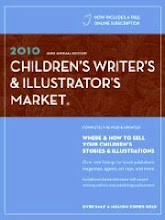The Picture Book Panel...
Barbara Seuling moderated this panel on creating picture books, with panelists Laurent Linn, senior designer at Henry Holt; Elizabeth Parisi, Executive Art Director at Scholastic (both of whom were judges for the portfolio display); and illustrator Melissa Sweet.
Barbara presented questions to the panelists about various aspects of picture book creation to be addressed from their varying perspectives. Here are some answers to one question I hear discussed often.
Why aren't most authors and illustrators involved in choosing illustrators and why don't illustrators and authors communicate while they're working on the same picture book?
Laurnet Linn called this question "the elephant in the room that no one talks about," but they talked about it. The panelists gave several good reason for the way things work in the picture books world when it comes to these issues:
- Publishers have a better grasp on the illustrators who are out there and are experts at pairing text and illustrations into the best package.
- A picture book is 50/50 when it comes to authors and illustrators telling the story. Illustrators need the freedom to create their own interpretation of the story without the interference of the writer; afterall, a writer wouldn't want an illustrator to make suggestions on how they should create or alter their text. Such collaboration would muddy the vision and arrest creativity.
- If an author is involved, it makes the already long process of creating a picture book even longer.







1 comment:
"after all, a writer wouldn't want an illustrator to make suggestions on how they should create or alter their text. Such collaboration would muddy the vision and arrest creativity."
I know this is a common perception with editors, and I do understand it - having met some very difficult authors over the years. However, the other side of this is a recent experience a writer friend had where she was allowed to work with the illustrator (who was very experienced and my friend was a new writer). The illustrator made a lot of terrific suggestions for reworking the story as the illustrations developed, simply because the illustrations gradually took the place of some of the words. The text ended up being reduced by nearly half, resulting in a beautiful book where the text and illustrations truly worked in harmony. I know the editor is usually the one who helps the writer rework the text as the illustration roughs come in, but sometimes that really is the roundabout way of doing it, and maybe not as productive for the overall book. Just a thought from me!
Post a Comment